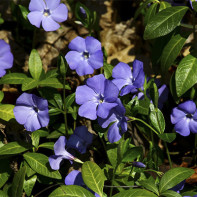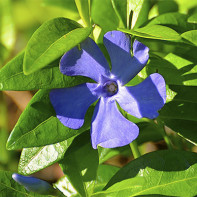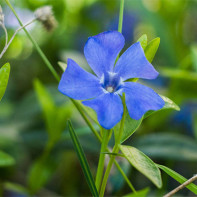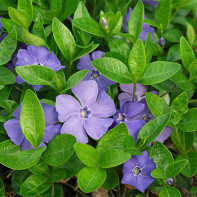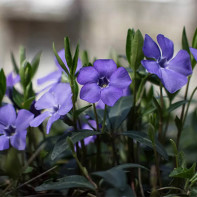Holy periwinkle: medicinal properties and contraindications
Nature has endowed the periwinkle with an amazing vitality. It is not afraid of frosts and heat, grows in poor soils, skillfully evades strong winds by falling to the ground. According to beliefs, it has mystical properties, is able to scare away evil forces from homes, neutralize negative energy. Wreaths with this flower were given by girls to their chosen one, pinned over the door and kept as a talisman, having previously dried several blue wreaths. The medicinal properties of the plant are especially valued, so it is often planted in dacha and homestead plots, obtaining a bright flowerbed and medicinal raw materials.
- How it looks and where it grows
- Types
- Collection and storage
- Chemical composition
- Therapeutic properties of the herb periwinkle
- Holy periwinkle in folk medicine
- Tincture to enhance potency
- Infusion for hypertension
- Composition for the treatment of vegetovascular dystonia
- Meteosensitivity and migraine
- Atherosclerosis
- Diarrhea, dysentery
- Infertility
- Skin diseases, wounds, insect bites
- Diathesis
- Cosmetic applications
- Preparations based on periwinkle
- Contraindications to use
How and where it grows
The periwinkle has several other names reflecting its properties or appearance. So it is called blueberry for the coloring of its flowers, gravedigger for its predilection for dwelling in cemeteries, and ivy. The Latin name comes from the verb "to entwine". Indeed, the creeping shrub willingly climbs to a considerable height, using any vertical or sloping base for support. Some herbaceous species have an erect stem with a flower on top. The leaves are dense, covered with a film that prevents them from drying out. They are able to retain their green color even under the snow, and in the spring they begin to bloom among the first flowers. Flowers are blue, large, in semi-shrubs are located mainly in the axils of the leaves. The main shade is blue, sometimes there are varieties with white, purple or pink flowers.

Interesting: The vitality of the plant is so high that, taken out of the vase in a half-wilted state and placed in wet soil, it quickly revives and takes roots.
Blueberry blooms in May; the corollas are funnel-shaped and open gradually. Flowering specimens produce fruit in the form of two leaflets, elongated in length. In nature, there are 4 main species, but breeders have bred several other ornamental varieties, which have acquired a more lush appearance, have not lost their medicinal properties.
The plant is so undemanding that once in a new place, instantly take root, and to get it out of there is very difficult. In the wild grows in Europe, Africa and Asia. It occurs in most parts of Russia, fond of roadside strips and deciduous forests. Its branches cover the ground as a continuous carpet, quickly taking root with the help of stem knots.
Thanks to its amazing vitality, the flower began to be planted in cemeteries as a sign of remembrance and loyalty. It needs no special care and grows beautifully there, being content with rain as watering.
Types
Altogether there are about 12 of them, it is difficult to say exactly, as new variations are constantly being discovered, which scientists have not yet classified. Five species are well known and loved by gardeners.
- Large. Named for its outstanding size for the species. Vertical shoots stretch to 150 cm high, leaf plates of rich green color, wide. The color of the flowers is blue with a contrasting light middle, diameter of the corollas reaches 5 cm. Grows quickly, is not sensitive to the level of light, can grow in shady places. In winter it requires additional covering with lapnuts to protect the root system.
- Small. Frost-resistant species has a terrific ability to adapt in a new place. It belongs to the evergreen group, as leaves remain even under snow. It differs from other species by its denser and more frequent planting of dark green oblong leaf plates. Blossoms in May, and with proper care is capable of forming buds a second time, in the fall. The color of the flowers in the classic version is blue. Decorative varieties with white, red, mottled, fringed flowers of simple and macroform are produced. The shade of the leaves can be silver or mottled. It is undemanding to soil composition, easy to root on stony slopes, in pine and mixed forests.
- Pubescent. Most often found in the Caucasus and Primorye. Features an increased rate of regeneration and the ability to take root in a short time in almost any soil. It doesn't tolerate cold weather, its leaves die off in winter, opening under the first warm rays in early spring. Blossoms in May, flowers up to 3.5 cm in diameter. Young stems form throughout the season until late fall. To prevent them from freezing, the bed is insulated for the winter.
- Grassy. Grows in the Crimea, Europe and the Caucasus. It grows well on elevated sunny hillsides, does not like the close presence of subsoil water, and avoids swampy areas. The flowers are blue, five-petaled, with narrowed tips. They bloom for 20-25 days, then seeds are formed.
- Pink. Characterized by abundant upright shoots rising up to half a meter in height. The dark green leaves have a distinct longitudinal light stripe running from petiole to tip. Flowering is long, beginning in May and ending in early September. When they open, the periwinkle forms a delicate pink carpet on a contrasting green background of leathery leaves.
Of the ornamental varieties, the most loved by gardeners are:
- Perepmint Cooler;
- Mediterranen;
- Cascade Appleblossom.
It is grown from seed. Blueberry grows quickly, forming a continuous carpet. In landscape design, it combines perfectly with primrose, honeydew, forget-me-nots. When planting, you need to immediately limit its growth zone, otherwise the semi-shrub instantly turns into a ubiquitous weed.
Gathering and storage
When harvesting medicinal raw materials, it is very important to observe the timing. Blueberry gathers its main force during flowering, so collect it in early June, cutting the shoots at a height of 4-5 cm from the ground. Most often harvest the small periwinkle, mixing with other species is undesirable, they are collected and dried separately.
It is worth considering: harvesting in one place is carried out once every 3 years. With more frequent visits, the plant population does not have time to recover and becomes weakened, with a reduced amount of useful substances.
Dry the green mass together with the flowers in a shaded, well-ventilated place. You can use an electric dryer at or below 50 degrees.
Chemical composition
The leaves and flowers contain more than 20 types of alkaloids, for which it is valued by herbalists when compiling gatherings aimed at alleviating cancer patients. In addition, the ground part of the plant contains:
- ascorbic, succinic, malic acid;
- sugars;
- phytosteroids;
- triterpene saponins;
- bitterness;
- pectin;
- carotene;
- flavonoids;
- cardiac glycosides.
Important: the plant is poisonous, uncontrolled reception without observing the dosages and proportions in the recipes is dangerous to health.
Medicinal properties of the herb periwinkle
The use of periwinkle is very wide. Not for nothing it was taken under protection and it is not recommended to pull the plants with the roots or completely destroy the sprawling glade when harvesting. Despite its phenomenal ability to root and propagate, it simply does not have time to regenerate with uncontrolled harvesting.

The plant has vasodilating, antimicrobial, soothing, and astringent properties. It can inhibit the development of cancer cells, relieve chronic pain and inflammation, lower blood pressure, stabilize the genitourinary and cardiovascular systems.
On the basis of extracts and extracts from the plant produce medicines. Receiving decoctions and infusions are recommended:
- for frequent vascular spasms, headaches, migraine;
- avitaminosis;
- fragile vascular walls;
- hypertension;
- circulatory disorders;
- diseases of the respiratory system;
- upset stomach;
- neurosis, emotional instability, depression;
- osteochondrosis;
- atherosclerosis;
- elevated intracranial pressure;
- atrophic changes in the eye fundus and retina;
- febrile conditions;
- sexual weakness;
- diseases of the brain.
A good effect is given by gargling decoction for toothache and bleeding gums. It is used as part of complex therapy in the treatment of infertility, chronic inflammation of the ovaries.
Coriander in folk medicine
The plant is included in the official register of medicinal herbs. Dried raw material is sold in pharmacies, blueberry is included in complex collections from hypertension, peptic ulcer and vegetovascular dystonia. Some remedies can be prepared on their own, carefully observing the proportions and the technology of manufacture. Excellent results give the use of decoctions and infusions for the treatment of female illnesses, for which in ancient times it was attributed magical properties.
Interesting: One of the names of the small periwinkle is witch's violet.
There are many recipes for healing compositions, they can be divided conditionally into decoctions, water and alcohol infusions, ointments.
Tincture to enhance potency
To prepare take 100 g of dry raw materials for 500 ml of medical alcohol. The herb is poured and insist 14 days in a dark place. For better dissolution of useful substances, the container is shaken daily. The dosage is in drops, 5 per dose. They are diluted in 1 tbsp water. Take twice a day. The maximum dosage is 10 drops per day. The course is 4 days, then you need a break for 2 days. Three approaches are required. The remedy has a cumulative effect, so tangible results appear only at the end of the course of treatment.
It is worth considering: For alcoholic and aqueous infusions, the herb must be thoroughly crushed to enhance its effect.
Infusion for hypertension
For a glass of boiling water, take 1 tbsp. of dried periwinkle and put on a water bath, incubated for 15 minutes. After the decoction has cooled to room temperature, it is filtered, the herb is squeezed. Divide into equal parts and take three times a day.
Collection for the treatment of vegetovascular dystonia
In equal doses mix:
- The leaves of periwinkle and cranberry;
- valerian root;
- Cranberry bark.
In 6 tablespoons of the mixture add 3 tablespoons of mistletoe and 1 caraway seed. After thoroughly mixing, 1 tbsp. of the mixture is separated. Pour it with 200 ml of boiling water, put on a water bath for a quarter of an hour. After that, incubated for 45 minutes under heat, filtered, squeeze the raw material and refill the glass. Reception is carried out on 100 ml 3-4 times a day before a meal. Course duration is 3-4 weeks. At this time it is desirable to revise the diet, reducing the amount of salt consumed and replacing sugar with honey.
Meteosensitivity and migraine
With age, people become more sensitive to variations in atmospheric pressure and begin to tolerate severe weather changes. Some discount it on age, not wanting to bother searching for a cure. And it is literally under your feet.
1 tsp. dried witch's violet infused with a glass of boiling water and leave under a towel for 20 minutes. Take 1 tbsp. spoon half an hour before a meal, the duration of treatment - 30 days.
Important: The shelf life of the decoction does not exceed 48 hours.
Atherosclerosis .
In this disease, the intensity of blood supply to the brain is impaired. The effectiveness of periwinkle is due to the presence of special alkaloids that stimulate blood flow. In a water bath, prepare a decoction of 1 tablespoon of periwinkle and a glass of water. Then bring the volume of liquid to 200 ml and take in equal parts during the day before meals. After a break of 10 days the course is repeated until the stabilization of blood pressure. Under the same scheme is the prevention of hypertensive crises.
Diarrhea, dysentery
Decoction is prepared in the proportion of 1 tbsp of raw materials in 300 ml of water. Then it soaks for 20 minutes over low heat, cool, take 100 ml 3 times a day until normalization of bowel function. The remedy is also effective as a gargle for angina, stomatitis, bleeding gums.
Infertility .
The problem is very serious, and you should not fully rely on pharmacy preparations. A higher result gives a complex therapy with the use of herbal infusions, normalizing the tone of the uterus. 1 tsp blueberry is ground into powder and pour a glass of boiling water. Stir without straining. Take 6 times a day, one sip for 14 days.
Skin diseases, wounds, insect bites.
Outwardly decoctions are used to wash cuts and scratches. Lotions are applied for 15 minutes for soggy dermatitis, eczema, ulcers, burns, psoriasis, dermatitis.
When biting mosquitoes and midges just wipe the skin with a cotton pad or rag soaked in decoction of periwinkle. Within a few minutes, the itching subsides, the swelling goes down.
Diathesis
Coriander is used to prepare an ointment for external use. You need exactly the fresh leaves, not lost juice. They are grinded, combined with 20 g of butter and peretalivayut. Then let cool slightly, filtered through gauze and poured into a jar. Store in the refrigerator. Children swab the sore spots once a day, adults are allowed to double the dosage. More often the remedy is not used, because the plant is poisonous, and instead of good, you can hurt yourself.
Cosmetic applications
Alkaloids in the composition of witch's violet stimulate cell regeneration, improve the complexion, maintain skin turgor. Decoction of 1 tsp. per glass of boiling water is called rejuvenating for its powerful effect on the epidermis. It just washes or make warm compresses, soaked in a liquid cotton towel on the face and décolleté zone. Invigorates and reduces wrinkles with an ice cube of decoction of periwinkle.

Blueberry does not irritate the delicate skin of the eyelids and around the eyes. This property is successfully used to care for it, to relieve fatigue and stress after a day of work.
preparations based on periwinkle
The main value for pharmacology is the alkaloid vincamine, extracted from the extract of the periwinkle. It has a beneficial effect on the blood vessels of the brain, restoring the intensity of blood flow, preventing the onset of ischemia and atherosclerosis. It normalizes metabolism, stimulates the activity of neuronal connections, increases concentration, performance, and relieves stress without the effect of inhibition. On the basis of the unique alkaloid are produced drugs aimed at normalizing brain functions, increasing capillary permeability, improving memory and attention, relieving symptoms of delayed speech and constant headaches provoked by emotional overstress. Such medications include:
- Vinpocetine;
- Cavinton;
- Oxibral;
- Vincapan;
- Vinebralan.
Contraindications to use
You should be examined by a cardiologist before using blueberry-based remedies. The fact is that some of the substances in the green mass of the plant act on the heart muscle in a depressing way, and you need to rule out the possibility of complications in advance. The controlling indicator will be a decrease in the pulse rate. In this case, the course of treatment with decoctions or preparations based on periwinkle stop.
Do not use herbal gatherings based on witch's violet in bradycardia, chronic constipation, hypotension, brain tumors, allergies. In pregnancy and breastfeeding, too, it is worth replacing the periwinkle with other remedies.
Need to know: preparations and folk remedies on the basis of periwinkle actively remove fluid from the body. This relieves the problem of edema, but can provoke excessive dehydration.
Treatment is stopped if persistent nausea, dizziness, loss of appetite, muscle weakness, neuralgia began. Such phenomena signal a serious overdose or individual intolerance of the substances.
It is worth planting periwinkle in the garden or in the country house, admiring its bright corollas of flowers and remembering that there is a powerful tool at hand to maintain beauty and health.
«Important: All information on this site is provided for informational purposes only purposes only. Consult a health care professional before using any of our recommendations. specialist before applying any recommendations. Neither the editors nor the authors shall be liable for any possible harm caused by materials."

